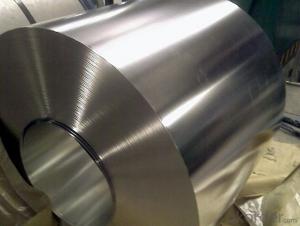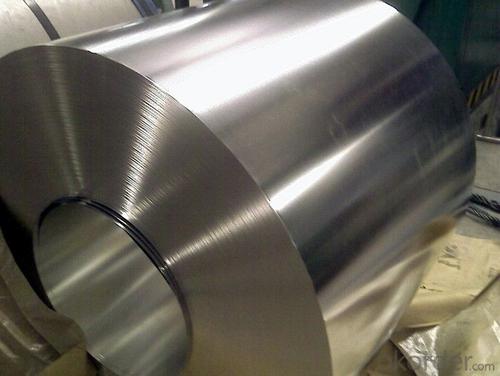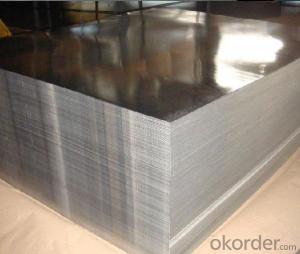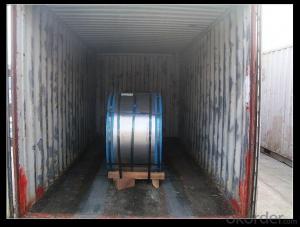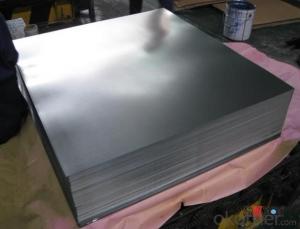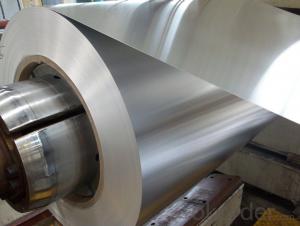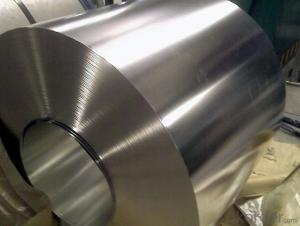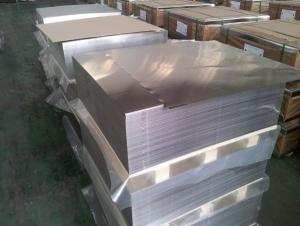Electrolytic Tinplate Coils / Sheets for Foods Packaging
- Loading Port:
- Tianjin
- Payment Terms:
- TT OR LC
- Min Order Qty:
- 25 m.t
- Supply Capability:
- 7000 m.t/month
OKorder Service Pledge
OKorder Financial Service
You Might Also Like
1.Structure of Electrolytic Tin Plate Coils and Sheets for Foods Metal Packaging Description
Electrolytic Tin Plate Coils and Sheets for Foods Metal Packaging, is one thin steel sheet with a coating of tin applied by electrolytic deposition. Tinplate made by this process is essentially a sandwich in which the central core is strip steel. This core is cleaned in a pickling solution and then fed through tanks containing electrolyte, where tin is deposited on both sides. As the strip passes between high-frequency electric induction coils, it is heated so that the tin coating melts and flows to form a lustrous coat.
2.Main Features of the Electrolytic Tin Plate Coils and Sheets for Foods Metal Packaging
Appearance – Electrolytic Tin Plate is characterized by its beautiful metallic luster. Products with various kinds of surface roughness are produced by selecting the surface finish of the substrate steel sheet.
Paintability and printability – Electrolytic Tin Plates have excellent paintability and printability. Printing is beautifully finished using various lacquers and inks.
Formability and strength – Electrolytic Tin Plates have got very good formability and strength. By selecting a proper temper grade, appropriate formability is obtained for different applications as well as the required strength after forming.
Corrosion resistance – Tinplate has got good corrosion resistance. By selecting a proper coating weight, appropriate corrosion resistance is obtained against container contents. Coated items should meet 24 hour 5 % salt spray requirement.
Solderability and weldability – Electrolytic Tin Plates can be joined both by soldering or welding. These properties of tinplate are used for making various types of cans.
Hygienic – Tin coating provides good and non toxic barrier properties to protect food products from impurities, bacteria, moisture, light and odours.
Safe – Tinplate being low weight and high strength makes food cans easy to ship and transport.
Eco friendly – Tinplate offers 100 % recyclability.
Tin is not good for low temperature applications since it changes structure and loses adhesion when exposed to temperatures below – 40 deg C.
3.Electrolytic Tin Plate Coils and Sheets for Foods Metal Packaging Images
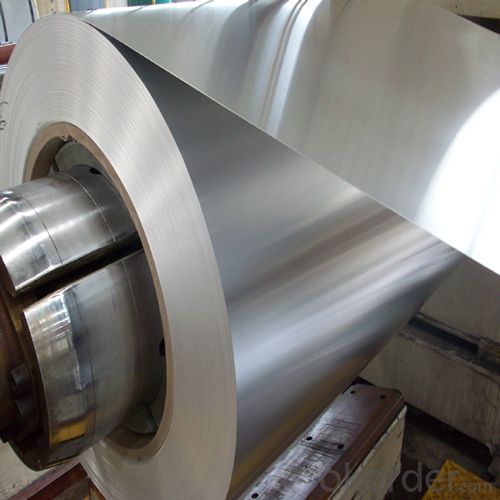

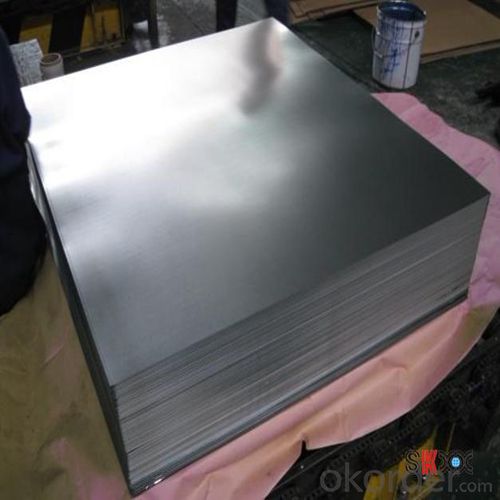
4.Electrolytic Tin Plate Coils and Sheets for Foods Metal Packaging Specification
Standard | ISO 11949 -1995, GB/T2520-2000,JIS G3303,ASTM A623, BS EN 10202
|
Material | MR,SPCC |
Thickness | 0.15mm - 0.50mm |
Width | 600mm -1150mm |
Temper | T1-T5 |
Annealing | BA & CA |
Coil Inner Diameter | 508mm |
Weight | 6-10 tons/coil 1~1.7 tons/sheets bundle |
Passivation | 311 |
Oil | DOS |
Surface | Finish,bright,stone,matte,silver |
5.FAQ of Electrolytic Tin Plate Coils and Sheets for Foods Metal Packaging
- How are the Electrolytic Tin Plates specified?
The Electrolytic Tin Plates are specified as per the steel base, extent of tempering, the coating weight, annealing method and the surface finish.
- How many types there are for base steels?
The base steels are of three types: Type MR, L, D
-What your tinplate material is used for ?
Tinplate is widely used for the packaging of products. Such as food cans,
beverage cans, pet cans, closures, general line cans and so on.
Printed Tinplate is offered!!
-How to place .an order or contact you ?
Please send us Email. we will give you a quick response in seconds .
- How is your quality ?
All our quality is prime even the secondary quality . We have many years experience
In this field with serious quality control standard . Advanced equipment, We welcome your visit to our factory .
- Q: What are the common applications of tinplate?
- Tinplate is commonly used for packaging food and beverages, such as cans for canned goods, metal caps for bottles, and metal containers for various products. It is also used for making aerosol cans, paint cans, and decorative tin boxes for storage purposes. Additionally, tinplate is used in the manufacturing of electronic components, automotive parts, and construction materials due to its corrosion resistance and durability.
- Q: What are the main innovations in tinplate manufacturing?
- One of the main innovations in tinplate manufacturing is the development of continuous annealing technology. This process allows for a more efficient and precise heat treatment of tinplate, resulting in improved mechanical properties and better coating adhesion. Additionally, the introduction of advanced coating systems, such as chromium-free passivation, has provided a more sustainable and environmentally friendly option for preserving the tinplate's surface and enhancing its corrosion resistance. Moreover, advancements in printing and decorative techniques have enabled manufacturers to create more visually appealing tinplate designs, catering to the evolving demands of consumers.
- Q: Can tinplate packaging be used for electronic products?
- Yes, tinplate packaging can be used for electronic products. Tinplate is a durable and corrosion-resistant material that provides good protection for electronic devices. It can be used to make packaging boxes, cases, or containers to safeguard and store electronic products effectively.
- Q: Can tinplate be used for high-pressure containers?
- No, tinplate is not suitable for high-pressure containers as it is not strong enough to withstand the pressure.
- Q: Can tinplate be used for chemical storage containers?
- Yes, tinplate can be used for chemical storage containers. Tinplate is a type of steel coated with a thin layer of tin, which provides excellent resistance against corrosion. This makes it suitable for storing various chemicals, as it helps to prevent any reaction between the stored substance and the container. Additionally, tinplate is durable and has good strength, making it a reliable option for chemical storage.
- Q: How does tinplate contribute to the shelf life of canned products?
- Tinplate contributes to the shelf life of canned products through its ability to prevent corrosion and maintain product quality. The tin coating on the steel substrate acts as a barrier, protecting the can from rusting and preventing any reaction between the metal and the food inside. This helps to maintain the integrity of the can, ensuring that it doesn't leak or become contaminated. As a result, tinplate cans can effectively preserve the freshness, taste, and nutritional value of the canned products, extending their shelf life significantly.
- Q: What are the common forms of corrosion that affect tinplate?
- Tinplate commonly experiences three forms of corrosion: uniform corrosion, pitting corrosion, and tin whisker growth. Uniform corrosion occurs evenly across the surface, leading to a thinning of the tin coating. Pitting corrosion, on the other hand, creates localized holes or pits, compromising the integrity of the tinplate. Lastly, tin whisker growth involves the formation of tiny, crystalline structures that can lead to short-circuits or other electrical issues.
- Q: How does tinplate packaging contribute to product freshness?
- Tinplate packaging contributes to product freshness by providing a protective barrier against oxygen, moisture, and light, which are factors that can deteriorate the quality and freshness of products over time. The airtight seal created by tinplate packaging helps to prevent oxidation and moisture absorption, preserving the flavor, aroma, and texture of the product. Additionally, tinplate packaging offers excellent light-blocking properties, which helps to protect light-sensitive products from degradation. Overall, the use of tinplate packaging plays a crucial role in extending the shelf life and maintaining the freshness of various products.
- Q: What are the main challenges in the tinplate industry?
- The main challenges in the tinplate industry include fluctuating prices of raw materials, increasing competition from alternative packaging materials, stringent environmental regulations, and the need for continuous technological advancements to improve production processes and meet changing customer demands. Additionally, the industry also faces challenges related to supply chain management, ensuring product quality and safety, and navigating global trade dynamics.
- Q: Can tinplate be used for signage and displays?
- Yes, tinplate can certainly be used for signage and displays. Tinplate is a versatile material that offers durability, strength, and a smooth surface for printing or painting. It can be easily shaped, cut, and formed to create various signage and display options, making it a popular choice for indoor and outdoor applications. Additionally, tinplate is resistant to corrosion, making it suitable for long-lasting and weather-resistant signage and displays.
Send your message to us
Electrolytic Tinplate Coils / Sheets for Foods Packaging
- Loading Port:
- Tianjin
- Payment Terms:
- TT OR LC
- Min Order Qty:
- 25 m.t
- Supply Capability:
- 7000 m.t/month
OKorder Service Pledge
OKorder Financial Service
Similar products
Hot products
Hot Searches
Related keywords
